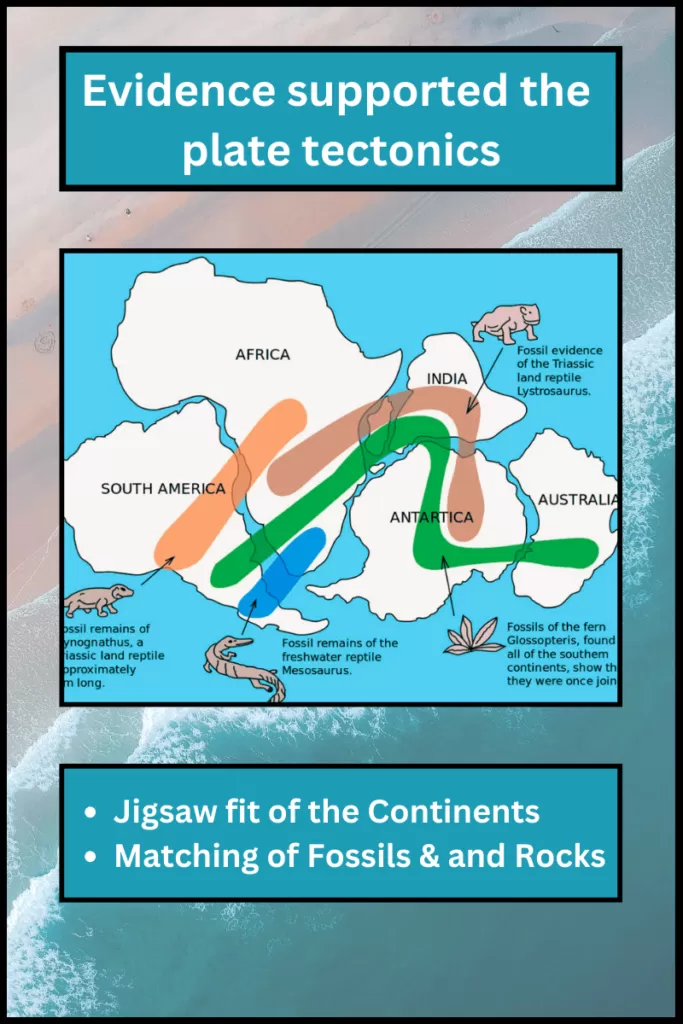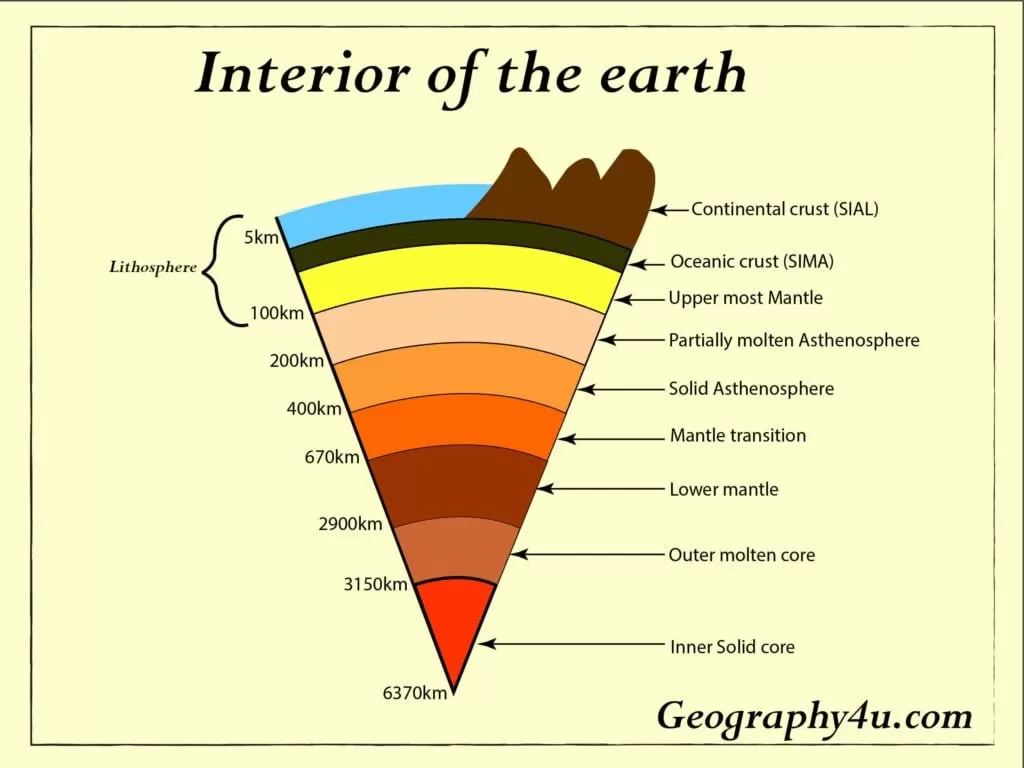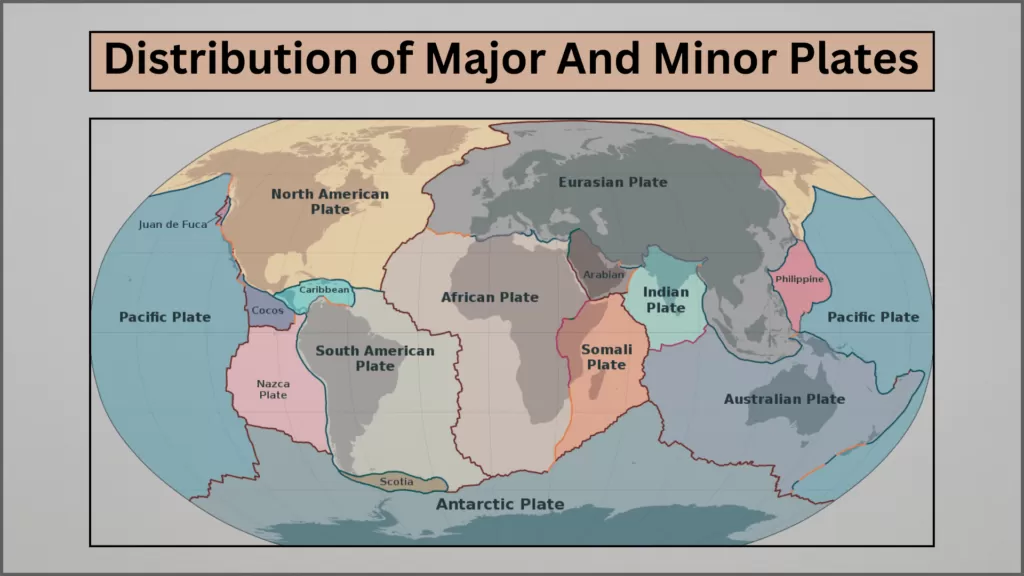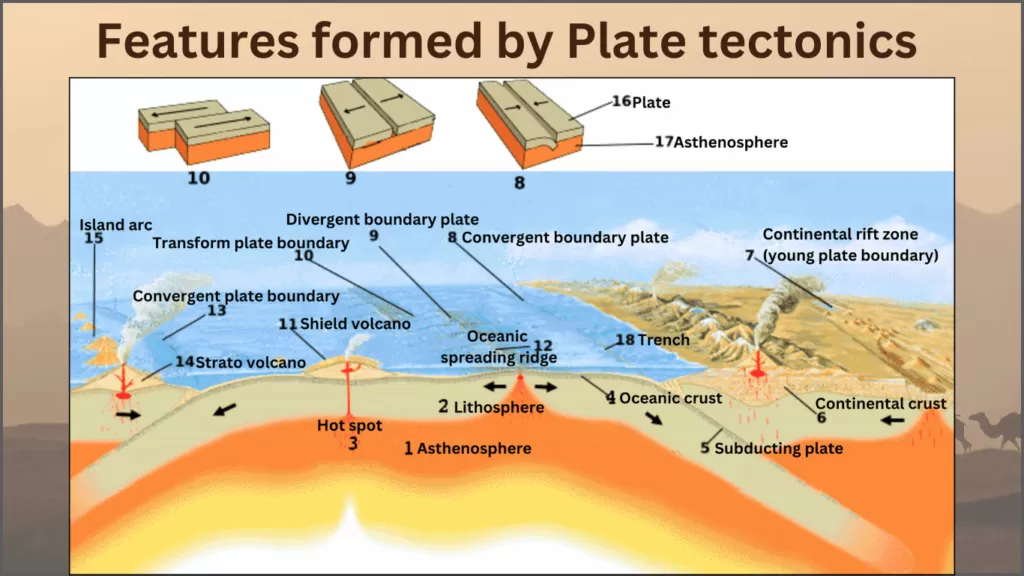Table of Contents
Theory of Plate Tectonics
The theory of plate tectonics explains how the Earth’s outer shell is divided into pieces like a jigsaw puzzle, and these pieces are always moving. They bump into each other, pull apart, or slide past each other, which causes things like earthquakes and volcanoes. This idea helps us understand why mountains exist and why continents are in their current positions. It’s like a big puzzle that helps scientists make sense of how the Earth’s surface changes over time.
How did the Plate tectonic theory evolve?
In the early 20th century, the Earth’s crust was believed to be static. But visionaries like Alfred Wegener dared to question this status quo. Wegener proposed the theory of continental drift, suggesting that continents were once connected and have since drifted apart. Although met with skepticism initially, Wegener’s idea laid the groundwork for the modern theory of plate tectonics, which gained widespread acceptance in the mid-20th century.
| Stage | Description |
| 1. Early Observations | The similarity of continents’ coastlines, such as the east coast of South America and the west coast of Africa. |
| 2. Continental Drift Hypothesis (Early 20th Century) | Alfred Wegener proposed the theory of continental drift in 1912, suggesting that continents were once connected and drifted apart. |
| 3. Evidence Accumulation | Evidence supporting continental drift emerged: matching fossils and rock layers on separated continents, distribution of earthquakes and volcanoes along specific zones. |
| 4. Plate Tectonics Emergence (Mid-20th Century) | The theory of Plate Tectonics began to take shape in the 1950s and 1960s. – Seafloor spreading was discovered, explaining how new oceanic crust forms at mid-ocean ridges. – Harry Hess proposed the idea of mantle convection driving plate movement. – Scientific consensus shifted towards this new theory. |
| 5. Modern Plate Tectonics Theory | In the 1960s, the Plate Tectonics theory became widely accepted. – It incorporated the ideas of seafloor spreading, mantle convection, and the movement of lithospheric plates. – This theory explained the dynamics of the Earth’s crust and reshaped the field of geology and geography. |
| 6. Ongoing Research and Refinement | Since its establishment, the Plate Tectonics theory has been continuously refined and expanded upon. – Ongoing research investigates the finer details of plate interactions, the causes of plate movement, and their consequences on Earth’s surface. |
| 7. Present Understanding | Today, the Plate Tectonics theory forms the cornerstone of our understanding of the Earth’s geology and is integral to studying geological phenomena such as earthquakes, volcanoes, mountain formation, and the shifting of continents. |
Assumptions made to support the Theory of plate tectonics
The theory of plate tectonics is built on several key assumptions that help to explain the movement of the Earth’s lithospheric plates and the dynamic nature of the planet’s surface. These assumptions are based on extensive scientific evidence and observations. Here are the primary assumptions of the theory of plate tectonics:
- Lithospheric Plates Exist – The theory assumes the existence of distinct lithospheric plates that make up the Earth’s outer shell. These plates are rigid and float on the semi-fluid asthenosphere below.
- Plate Boundaries Are Active Zones – It is assumed that plate boundaries are active zones where significant geological
processes occur. These boundaries can be convergent (plates move toward each other), divergent (plates move away from each other), or transform (plates slide past each other horizontally). - Plate Movement Is Ongoing – The theory assumes that plate movement is an ongoing process. Plates are in constant motion, driven by forces such as mantle convection and the sinking of dense oceanic lithosphere into the mantle (subduction).
- Earth’s Interior Is Dynamic – The theory acknowledges the dynamic nature of the Earth’s interior. It assumes that heat generated from radioactive decay in the Earth’s mantle creates convection currents, which, in turn, drive the motion of tectonic plates.
- Plate Interactions Create Geological Features – It is assumed that interactions between tectonic plates at plate boundaries create various geological features. For example, convergent boundaries can lead to the formation of mountain ranges, deep ocean trenches, and volcanic arcs.
- Plate Movements Affect Earth’s Surface – The theory assumes that the movement of lithospheric plates has a direct impact on the Earth’s surface, including the distribution of continents, the opening and closing of ocean basins, and the formation of geological structures.
- Plate Movements Explain Earthquakes and Volcanic Activity – The theory assumes that the movement and interactions of tectonic plates are responsible for the occurrence of earthquakes and volcanic eruptions. Earthquakes often result from the release of stress along plate boundaries, while volcanoes are associated with magma rising from the mantle.
- The Theory Is Supported by Geological Evidence – The assumptions of plate tectonics are supported by several geological evidence, including the fit of continents, the distribution of earthquakes and volcanoes, the pattern of magnetic striping on the ocean floor, and the correlation of fossils and rock layers across continents.
- Plate Tectonics Operates Over Geological Time Scales – The theory operates on geological time scales, meaning that the movement and rearrangement of continents and ocean basins occur over millions of years. It assumes that the Earth’s surface has undergone significant changes throughout its history.
These assumptions collectively provide a framework for understanding the dynamic behavior of the Earth’s lithosphere and the processes that shape the planet’s surface. The theory of plate tectonics has revolutionized the field of Earth science, providing a unifying explanation for a wide range of geological phenomena.
The evidence supported the plate tectonics theory
Here are some key lines of evidence that support the theory of plate tectonics:

- Fit of the Continents- The coastlines of continents, particularly South America and Africa, appear tofit together like pieces of a jigsaw puzzle. This observation suggests that the continents were once connected, supporting the idea of continental drift, a precursor to plate tectonics.
- Matching Fossils and Rock Layers- Evidence Similar fossils and rock layers are found on continents that are now separated by oceans. The presence of identical or closely related fossils and geological formations on continents that are now widely separated suggests that these landmasses were once part of a larger whole.
- Seafloor Spreading- The discovery of mid-ocean ridges, underwater mountain ranges, and rift valleys along the ocean floor. Seafloor spreading is the process by which new oceanic crust is formed at mid-ocean ridges as tectonic plates move apart. This supports the idea that the Earth’s lithosphere is not static but is actively changing.
- Distribution of Earthquakes and Volcanoes- Earthquakes and volcanic activity are concentrated along plate boundaries. The occurrence of earthquakes and volcanoes is closely correlated with the boundaries of tectonic plates. This suggests that the interaction and movement of these plates are responsible for these geological phenomena.
- Paleoclimatic Evidence- Evidence of glaciation in regions that are now near the equator, such as glacial deposits and striations on rocks. The movement of continents to their current positions has caused dramatic shifts in climate zones over geological time scales. Evidence of past climates supports the concept of continental drift and plate movement.
- Palaeomagnetism- Magnetic minerals in rocks record the orientation of the Earth’s magnetic field at the time the rocks were formed. The alignment of magnetic minerals in rocks on the ocean floor shows apattern of alternating magnetic striping, mirroring the reversals of the Earth’s magnetic field. This provides evidence of seafloor spreading and the movement of tectonic plates.
- GPS and Plate Movement- Global Positioning System (GPS) technology allows precise measurement of the movement of tectonic plates. GPS measurements confirm that tectonic plates are in constant motion, supporting the plate tectonics theory.

- Earth’s Interior Structure- Seismic studies of the Earth’s interior have revealed distinct layers, includingthe solid lithosphere and the semi-fluid asthenosphere. The lithosphere is divided into tectonic plates, and the semi-fluid asthenosphere allows for the movement of these plates.
Collectively, these lines of evidence provide a compelling case for the theory of plate tectonics, demonstrating that the Earth’s lithospheric plates are not fixed but are constantly in motion, driving geological processes and shaping the planet’s surface.
What are tectonic plates?
Tectonic plates are massive, rigid pieces of the Earth’s lithosphere that fit together like a jigsaw puzzle to make up the planet’s outer shell. They are a fundamental concept in the theory of plate tectonics, which describes the movement and interactions of these plates.
| S.No. | Aspect of Tectonic Plates | Description |
| 1. | Composition | Tectonic plates are primarily composed of the Earth’s lithosphere, consisting of the crust and the uppermost part of the mantle. |
| 2. | Thickness | Tectonic plates are typically around 100 kilometres (62 miles) thick and include both continental and oceanic crust. |
| 3. | Types of Plates | 3a. Continental Plates: Composed mainly of continental crust, less dense, and thicker. Examples include the North American Plate. 3b. Oceanic Plates: Predominantly oceanic crust, denser and thinner. Examples include the Pacific Plate. |
| 4. | Plate Boundaries | Plates interact at three main types of boundaries: convergent (plates move toward each other), divergent (plates move away from each other), and transform (plates slide past each other horizontally). |
| 5. | Plate Movement | Tectonic plates are in constant motion, driven by forces such as mantle convection, where heat from the Earth’s interior generates convection currents. |
| 6. | Plate Interactions | Plate interactions at boundaries create geological features like mountain ranges, deep ocean trenches, volcanic arcs, and are responsible for phenomena such as earthquakes and the opening/closing of ocean basins. |
| 7. | Impact on Earth’s Surface | Tectonic plate movements influence the distribution of continents, ocean basins, and geological structures on Earth’s surface. |
| 8. | Driving Forces | Plate movement is primarily driven by mantle convection, where heat transfer in the mantle generates convection currents that push and pull the plates. |
| 9. | Dynamic Nature | Tectonic plates are not static; they are in continuous motion, shaping the Earth’s surface over geological time scales. |
Types of tectonic plates
Let’s explore the two main types of tectonic plates in more detail: continental plates and oceanic plates.
Continental Plates
- Composition: Continental plates are primarily composed of continental crust, which ismade up of a variety of rocks, including granite. Continental crust is less dense than oceanic crust.
- Thickness: Continental plates are generally thicker than oceanic plates, ranging from about 30 to 50 kilometers (18 to 31 miles) or more in thickness.
- Density: They are less dense than oceanic plates due to the lighter composition of continental crust.
- Landmasses: Continental plates often include extensive landmasses and large continents, such as North America, Eurasia, and SouthAmerica.
- Stability: Continental plates are relatively stable and less prone to subduction (sinking beneath another plate) compared to oceanic plates.
Oceanic Plates
- Composition: Oceanic plates are predominantly composed of oceanic crust, which consists mainly of basaltic rock. Oceanic crust is denser than continental crust.
- Thickness: Oceanic plates are thinner than continental plates, typically ranging from about 5 to 10 kilometers (3 to 6 miles) in thickness.
- Density: They are denser than continental plates due to the heavier composition of oceanic crust.
- Ocean Basins: Oceanic plates are typically found beneath the Earth’s oceans and are responsible for the formation of ocean basins.
- Subduction: Oceanic plates are more likely to be subducted beneath other plates at convergent boundaries due to their higher density.
Key Differences Between Continental Plates and Oceanic Plates
| Characteristics | Continental Plates | Oceanic Plates |
| Composition | Composed mainly of continental crust (granite). | Predominantly made up of oceanic crust (basalt). |
| Thickness | Generally thicker, ranging from about 30 to 50 km. | hinner, typically about 5 to 10 km thick. |
| Density | Less dense due to the lighter continental crust. | Denser due to the heavier oceanic crust. |
| Landmasses | Often include large continents and landmasses. | Typically found beneath oceans, forming basins. |
| Stability | Relatively stable, less prone to subduction. | More likely to be subducted at convergent boundaries. |
Distribution of major and Minor Plates
The Earth’s lithosphere is divided into several tectonic plates, both major and minor, which interact along plate boundaries. These plates play a crucial role in the theory of plate tectonics and the dynamics of the Earth’s crust. Here’s an explanation of the distribution of major and minor tectonic plates:

Major Tectonic Plates:
- Pacific Plate: The Pacific Plate is the largest tectonic plate, covering the Pacific Ocean. It is known for its high level of seismic activity, including the Pacific Ring of Fire, where it interacts with several other plates, leading to earthquakes and volcanic activity.
- North American Plate: This plate covers most of North America, including the United States, Canada, and parts of the Atlantic Ocean. It interacts with the Pacific Plate along the San Andreas Fault, resulting in significant seismic activity in California.
- Eurasian Plate: The Eurasian Plate encompasses Europe and Asia, including a portion of Russia. It forms convergent boundaries with several neighboring plates, leading to the formation of mountain ranges like the Alps and the Himalayas.
- African Plate: Covering Africa, the African Plate interacts with the Eurasian Plate along the Mediterranean region, creating mountain ranges and fault systems.
- South American Plate: The South American Plate includes South America and part of the Atlantic Ocean floor. It converges with the Nazca Plate, leading to the formation of the Andes Mountains.
- Indo-Australian Plate: This plate covers the Indian subcontinent, Australia, and the Indian Ocean. Its collision with the Eurasian Plate led to the rise of the Himalayan mountain range.
Minor Tectonic Plates:
- Nazca Plate: The Nazca Plate is located off the western coast of South America and is subducting beneath the South American Plate. This subduction zone is responsible for the Andes Mountains and the frequent occurrence of earthquakes along the western edge of South America.
- Cocos Plate: The Cocos Plate is located off the western coast of Central America and is subducting beneath the North American Plate. This subduction zone has generated earthquakes and volcanic activity in regions like Mexico and Central America.
- Philippine Sea Plate: Situated in the western Pacific Ocean, this plate interacts with several neighboring plates, including the Eurasian Plate and the Pacific Plate. Its complex boundaries contribute to seismic and volcanic activity in the Philippines and surrounding regions.
- Caribbean Plate: Covering the Caribbean Sea and parts of Central America, this plate interacts with the North American Plate and the South American Plate, causing earthquakes and volcanic eruptions in the Caribbean region.
- Arabian Plate: The Arabian Plate includes the Arabian Peninsula and parts of the surrounding region. It interacts with the African Plate and the Eurasian Plate, contributing to geological features like the Red Sea and the Zagros Mountains.
- Juan de Fuca Plate: Located off the Pacific Northwest of North America, this small plate interacts with the North American Plate, causing geological activity in the region, including the Cascade Range of volcanoes.
These major and minor tectonic plates make up the puzzle pieces of the Earth’s lithosphere. Their interactions along plate boundaries are responsible for various geological phenomena, including earthquakes, volcanic eruptions, mountain formation, and the creation of ocean basins. The study of these plates and their movements is essential for understanding the dynamic nature of our planet’s surface.
Tectonic plate movements
Tectonic plate movements occur due to the interactions of the Earth’s lithospheric plates, driven by forces within the planet. There are primarily three types of plate movements, each contributing to specific geological features and phenomena:
There are primarily three types of plate movements, each contributing to specific geological features and phenomena:
Types of Tectonic Plate Movements:
- Divergent Boundaries: At divergent boundaries, tectonic plates move away from each other. This movement creates tensional forces, leading to the formation of new oceanic crust. The most famous example of this is the Mid-Atlantic Ridge, where the Eurasian Plate and North American Plate are slowly moving apart, causing the Atlantic Ocean to widen. Volcanic activity is common along divergent boundaries as magma rises to create new crust.
- Convergent Boundaries: Convergent boundaries are zones where tectonic plates collide. When an oceanic plate collides with a continental plate, the denser oceanic plate typically sinks beneath the continental plate in a process called subduction. This can create deep ocean trenches and volcanic arcs on the overriding continental plate. When two continental plates collide, they can form massive mountain ranges like the Himalayas.
- Transform Boundaries: Transform boundaries occur when tectonic plates slide past each other horizontally. This lateral movement can create significant stress along fault lines, which can result in earthquakes. The San Andreas Fault in California is a famous example of a transform boundary.
Driving Forces of Plate Movements:
The driving forces behind plate movements are largely attributed to the convection currents within the Earth’s mantle. Here’s how it works:
- Heat generated by the radioactive decay of elements in the Earth’s core causes the mantle material to become semi-fluid.
- This semi-fluid material undergoes convection, where hotter, less dense material rises, and cooler, denser material sinks.
- As hot material rises, it pushes the overlying tectonic plates away, creating divergent boundaries.
- When cooler material sinks, it exerts a pull on the plates, causing them to move towards each other at convergent boundaries.
Plate Movement Rates:
Tectonic plate movement is relatively slow, typically measured in centimetres per year. For example, the Pacific Plate moves at a rate of several centimetres per year. While these speeds might seem insignificant, they accumulate over millions of years, leading to significant changes in Earth’s geography.
Plate Interactions and Geological Features:
The interactions of tectonic plates result in various geological features:

- Mountain Ranges: Formed at convergent boundaries when two continental plates collide and compress, leading to the uplift of the Earth’s crust.
- Ocean Basins: Created at divergent boundaries where new oceanic crust is formed, causing the seafloor to spread and oceans to widen.
- Volcanoes: Often found at convergent boundaries where one plate subducts beneath another, leading to the melting of rock and the formation of magma.
- Earthquakes: Common at transform boundaries and convergent boundaries due to the intense stress along fault lines.
Tectonic plate movements not only shape the Earth’s surface but also influence climate patterns, the distribution of ecosystems, and the location of valuable resources. They are a testament to the dynamic and ever-changing nature of our planet.
If you like the post, share it to your friends.
